Non-aqueous gels for consolidating and stabilizing wellbore formations
a wellbore and non-aqueous gel technology, applied in the direction of wellbore/well accessories, sealing/packing, chemistry apparatus and processes, etc., can solve the problems of loss of well control, loss of circulation, loss or decrease of production
- Summary
- Abstract
- Description
- Claims
- Application Information
AI Technical Summary
Problems solved by technology
Method used
Image
Examples
example 1
[0061]A gel was synthesized by mixing Cardolite® NC-547 and Jeffamine® T-5000 in a 1:1 ratio in mineral oil and heated to 70° C. After heating for 16 hours, a firm gel is formed.
[0062]
TABLE 1Effect of Added Tertiary Amine (Triisopropanolamine)HardnessLipophilicAmineTertiaryObservs.Observs. @aftermonomerBase OilcrosslinkerAmine@ 70° C.70° C.agingEpoxy Resin;83%8%1%Liq @ 6 hElastic Gel 85 psi8%16 hEpoxy Resin;82%8%2%Liq @ 6 hElastic Gel165 psi8%16 hEpoxy Resin;80%8%4%Liq @ 6 hElastic Gel218 psi8%16 h
EXAMPLE 2
[0063]The following non aqueous gel was formulated to illustrate the characteristics of an exemplary non aqueous gel:
[0064]
TABLE 2MaterialFunctionAmountDF1Base Oil10 mL Cardolite NC 547Epoxy Gelling Agent2 mLJeffamine T5000Trifunctional amine Gelling Agent2 mLTriisopropanolamineTertiary amine hardening agent0.2 mL
[0065]Cardolite® NC-547, Jeffamine® T-5000, Triisopropanolamine, and base oil are mixed with an equivalent concentration of the additives found in Table 3:
[0066]
TABLE 3...
example 2
[0070]Table 5 details a non aqueous gel formulated to illustrate the viscosity of an exemplary gel formulation:
[0071]
TABLE 5AdditiveAmountg or mIFunctionHDF190mlBase oilVERSAGEL2.3gOrganoclaySUPREMEJEFFAMINE T500045mlTrifunctional AminepolymerCARDOLITE45mlEpoxidised PolymerNC547ResinTriisopropanolamine0.3mlTertiary AminehardenerSTARCARB60gbridging solidFORDACAL 6041.2gbridging solidG-SEAL18.8gbridging solid
[0072]The components in Table 5 were mixed, and tested prior to gelling. The viscosity was measured using a Brookfield DV-II+ Viscometer using spindle LV2 at 0.3 rpm at 25° C. Table 6 details the typical viscosity ranges for the Brookfield DV-II+ Viscometer at 1, 2, and 3 minutes.
[0073]
TABLE 6Viscosity @(cps)1 m11,3002 m12,3003 m13,500
[0074]Thereafter, a repeat test was conducted to verify the viscosity of the mixture at various rotational speeds. The viscosity of the mixture at 25° C. was determined using a LV1 spindle. The resulting viscosities are listed in Table 7.
[0075]
TABLE ...
example 3
[0076]The following formulation in Table 8 illustrates the viscosity of an exemplary gel formulation comprising 10.5 ppg of carbonate:
[0077]
TABLE 8ProductSgWeightVolumeFunctionDiesel0.840113.82135.51Base oilVERSAGEL1.7004.502.65Organoclay ViscosifierSUPREMECARDOLITE0.90060.9867.75Epoxidised PolymerNC547ResinJEFFAMINE T50001.00367.9667.75Trifunctional AminepolymerTriisopropanolamine1.0104.564.52Tertiary AminehardenerSAFECARB 402.680119.0044.40bridging solidSAFECARB 2502.68020.007.46bridging solid(blend)SAFECARB 5002.68025.009.33bridging solid(blend)G-SEAL2.25025.0011.11bridging solid
[0078]The components listed in Table 8 were mixed and the viscosity was measured prior to the mixture gelling. The viscosity was measured using a Brookfield DV-II+ Viscometer with spindle LV1 at 0.3 rpm at 25° C. Table 9 details the resulting viscosity, measured at 1, 2, and 3 minutes.
[0079]
TABLE 9Time1 m2 m3 mSpindle 1Off scale atOff scale atOff scale atlowest speedlowest speedlowest speedSpindle 3 @ 0.3...
PUM
| Property | Measurement | Unit |
|---|---|---|
| initial viscosity | aaaaa | aaaaa |
| viscosity | aaaaa | aaaaa |
| temperature | aaaaa | aaaaa |
Abstract
Description
Claims
Application Information
 Login to View More
Login to View More - R&D
- Intellectual Property
- Life Sciences
- Materials
- Tech Scout
- Unparalleled Data Quality
- Higher Quality Content
- 60% Fewer Hallucinations
Browse by: Latest US Patents, China's latest patents, Technical Efficacy Thesaurus, Application Domain, Technology Topic, Popular Technical Reports.
© 2025 PatSnap. All rights reserved.Legal|Privacy policy|Modern Slavery Act Transparency Statement|Sitemap|About US| Contact US: help@patsnap.com



